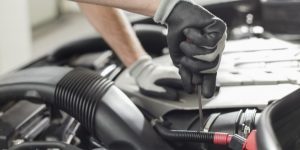Preparing Your Landscaping Equipment for the Winter Season
For landscaping businesses in locations with four distinct seasons, fall signals the end of lawn care jobs. Winter frost and snow renders most landscaping tasks moot, and for companies who switch over to snow removal during the winter season, it means storing spring equipment and breaking out the plows and snow blowers.
As you begin packing up landscaping equipment for the off-season, it’s important to take care and properly inspect and maintain each item. Some equipment should be winterized before storage to reduce the risk of damage during cold weather.
At Arborgold, we design software for businesses like yours, streamlining operations, marketing, customer engagement, scheduling, and more. Working with so many landscaping and lawn care companies, we’ve come to know the subtleties involved in preparing for each season. Here, we’ll share some tips on preparing your landscaping equipment for cold weather.
Manage Residual Fuel
In mowers and weed eaters, leftover fuel can cause problems during the winter season. Storing equipment with residual fuel in the lines could cause lines to freeze, corrode, or clog.
If you’re near the end of your fuel in a particular piece of equipment, it’s best just to drain the line and dispose of the old fuel carefully and follow your local waste management bylaws. For a newly filled mower or weed eater, you can use a fuel stabilizer to store the fuel for spring.
Fuel is impacted by oxidation, even while sealed tightly in a fuel tank or gas can. Over time, the breakdown of gas causes it to thicken. If you pour this thick fuel into a gas tank, it will clog lines and gum up the interior of your lawn care machines.
Fuel stabilizers stop oxidation by working simultaneously as an antioxidant and a liquid absorber. Some stabilizers claim to last up to 2-years, guaranteeing your fuel will store safely until the spring thaw.
To use stabilizer in your mowers and weed eaters, pour the specified amount (read the label) into your fuel tank, and run the mower to let it circulate. Store, and use in the spring with peace of mind knowing your gas lines are intact.
Inspect and Clean your Tools
Storing dirty, or damaged tools, not only makes your job a lot more difficult come spring, but it could cause further breakdown during storage.
Before you tuck away landscaping equipment for the winter season, thoroughly inspect each tool and attachment. Some areas to pay close attention to include:
- Spark plugs
- Deck
- Belts
- Blades
- Filters
Each piece of equipment should be cleaned and sanitized, carefully removing any debris, grass, and mud. Any residual water should be wiped away to reduce the risk of rusting or corrosion over winter.
Remove Oil for Winter
Motor oil is a mixture, including gas. As it gets used throughout the landscaping season, it also collects sediment and moisture as you work, which, if left for an entire season, could corrode your mower.
To winterize your lawnmower, you should remove oil for storage. To do this:
- Lay down a tarp to protect your driveway or garage.
- Use a pan to catch oil.
- With the carburetor pointing up, tip the mower on its side so the oil doesn’t leak into your air filter and carburetor.
- Pull the plug on the oil tank.
- Watch oil drain until nothing else drips out.
- Put the plug back into the oil reservoir.
- Clean up and store mower.
Be careful when disposing of oil that you follow local bylaws for waste management. You should also be careful when you replace your motor oil. Use your mower’s user guide to determine which oil is best for your machine.
Make Replacements Early
It’s tempting to wait until spring to replace the pieces your landscaping machines require but replacing them in the winter will save you time later and ensure everything is in working order when business picks up.
Spark Plug
One of the components you may need to replace is the spark plug. This is an affordable change to make, and one which will keep your mower running better, longer. Removing the plug is easy.
Use a socket wrench (you may need to purchase a spark-plug socket, which is designed to protect the plug from cracking during removal). Replace with a new plug and voila! That’s all there is to it. Spark plugs run between $6 to $20, making it a cheap investment in the long run.
Blades
We also recommend sharpening and replacing damaged blades now, rather than waiting until spring. There’s nothing worse than preparing for a landscaping job as the season commences, only to find you need a new blade and parts will take weeks to arrive.
Before removing the blade, remove the spark plug wire. Next, turn the retaining bolt to the left (in most cases). Now you can remove the blade and tip to clean and/or replace the blade. Reconnect the spark plug wire and you’re ready to mow.
Filters
Mower filters vary by machine. If yours has a sponge filter, it may just need a good cleaning. It can be washed in soap and water. Be sure to dry and oil it before replacing the filter.
Wipe cooling fins while the filter is removed to ensure optimal performance come spring.
If your machine has a paper filter, there’s no saving it. You’ll need to remove the filter and replace it. The paper edge should face outward when you put the new filter in.
Learn More About Arborgold
Arbogold software is made for seasonal companies to help your business run smoothly no matter which projects you’re currently taking on. We work with field-based companies across a variety of industries, including:
- Landscaping
- Snow removal
- Pest control
- Lawn care
- Construction
Arborgold is constantly working to expand and evolve our software to include more of the services and features needed in an ever-changing business landscape.
Interested in learning more about Arborgold and how our software can benefit your field-based business? We invite you to visit us online and take the Arborgold tour today.
Share this resource




